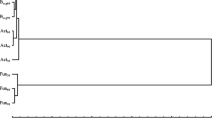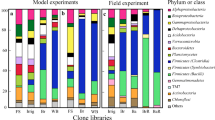Abstract
Biological soil disinfestation (BSD) involves the anaerobic decomposition of plant biomass by microbial communities leading to control of plant pathogens. We analyzed bacterial communities in soil of a model experiment of BSD, as affected by biomass incorporation under various conditions, to find out the major anaerobic bacterial groups which emerged after BSD treatments. The soil was treated with Brassica juncea plants, wheat bran, or Avena strigosa plants, irrigated at 20 or 30 % moisture content and incubated at 25–30 °C for 17 days. The population of Fusarium oxysporum f. sp. spinaciae incorporated at the start of the experiment declined markedly for some BSD conditions and rather high concentrations of acetate and butyrate were detected from these BSD-treated soils. The polymerase chain reaction-denaturing gradient gel electrophoresis analysis based on the V3 region of 16S rRNA gene sequences from the soil DNA revealed that bacterial profiles greatly changed according to the treatment conditions. Based on the clone library analysis, phylogenetically diverse clostridial species appeared exceedingly dominant in the bacterial community of BSD soil incorporated with Brassica plants or wheat bran, in which the pathogen was suppressed completely. Species in the class Clostridia such as Clostridium saccharobutylicum, Clostridium acetobutylicum, Clostridium xylanovorans, Oxobacter pfennigii, Clostridium pasteurianum, Clostridium sufflavum, Clostridium cylindrosporum, etc. were commonly recognized as closely related species of the dominant clone groups from these soil samples.






Similar content being viewed by others
References
Altschul SF, Madden TL, Schäffer AA, Zhang J, Zhang Z, Miller W, Lipman DJ (1997) Gapped BLAST and PSI-BLAST: a new generation of protein database search programs. Nucleic Acids Res 25:3389–3402
Bailey KL, Lazarovits G (2003) Suppressing soil borne diseases with residue management and organic amendments. Soil Till Res 72:169–180
Beppu T, Ueda K (2009) Genus I. Symbiobacterium Ohno, Shitatori, Park, Saitoh, Kumon, Yamshita, Hirata, Nishida, Ueda and Beppu 2000, 1832VP. In: Whitman WB, Parte AC (eds) Bergey’s manual of systematic bacteriology, vol 3. Springer, New York, pp 1188–1190
Blok WJ, Lamers JG, Termorshuizen AJ, Bollen GJ (2000) Control of soilborne plant pathogens by incorporating fresh organic amendments followed by tarping. Phytopathology 90:253–259
Collins MD, Lawson PA, Willems A, Cordoba JJ, Fernandez-Garayzabal J, Garcia P, Cai J, Hippe H, Farrow JAE (1994) The phylogeny of the genus Clostridium: proposal of five new genera and eleven new species combinations. Int J Syst Bacteriol 44:812–826
Fierer N, Schimel JP, Holden PA (2003) Influence of drying rewetting frequency on soil bacterial community structure. Microb Ecol 45:63–71
Gans J, Wolinsky M, Dunbar J (2005) Computational improvements reveal great bacterial diversity and high metal toxicity in soil. Science 309:1387–1390
Good IJ (1953) The population frequencies of species and the estimation of population parameters. Biometrika 40:237–262
Goud JKC, Termorshuizen AJ, Blok WJ, van Bruggen AHC (2004) Long-term effect of biological soil disinfestation on Verticillium wilt. Plant Dis 88:688–694
Hammer Ø, Harper DQAT, Ryan PD (2001) PAST: Paleontological statistics software package for education and data analysis. Palaeontologia Electronica 4:4. http://palaeo-electronica.org/2001_1/past/issue1_01.htm
Janssen PH (2006) Identifying the dominant soil bacterial taxa in libraries of 16S rRNA and 16S rRNA genes. Appl Environ Microbiol 72:1719–1728
Kaku N, Ueki A, Ueki K, Watanabe K (2005) Methanogenesis as an important terminal electron accepting process in estuarine sediment at the mouth of Orikasa River. Microb Environ 20:41–52
Katan J (1981) Solar heating (solarization) of soil for control of soil borne pests. Annu Rev Phytopathol 19:211–236
Katan J (2000) Physical and cultural methods for the management of soil borne pathogens. Crop Prot 19:25–31
Krumholz LR, Bryant MP (1985) Clostridium pfennigii sp. nov. uses methoxyl groups of monobenzenoids and produces butyrates. Int J Syst Bacteriol 35:454–456
Kubo C, Ushio S, Katase M, Takeuchi T (2005) Analysis of factors involved in sterilization effect by soil reduction. Jpn J Phytopathol 71:281–282, abstract in Japanese
Kumar V, Singh KP (2001) Enriching vermicompost by nitrogen fixing and phosphate solubilizing bacteria. Biores Technol 76:173–175
Larkin RP, Griffin TS (2007) Control of soil borne potato diseases using Brassica green manures. Crop Prot 26:1067–1077
Logan NA, Vos PD (2009) Genus I. Bacillus Cohn 1872, 174AL. In: Whitman WB, Parte AC (eds) Bergey’s manual of systematic bacteriology, vol 3. Springer, New York, pp 21–111
Macfarlane J, Macfarlane GT (1995) Proteolysis and amino acid fermentation. In: Gibson GR, Macfarlane GT (eds) Human colonic bacteria. CRC Press, New York, pp 75–100
Maidak BL, Cole JR, Jr Parker CT, Garrity GM, Larsen N, Li B, Lilbum TG, McCaughey MJ, Olsen GJ, Overbeek R, Pramanik S, Schmidt TM, Tiedje JM, Woese CR (1999) A new version of the RDP (Ribosomal Database Project). Nucleic Acids Res 27:171–173
Messiha NAS, van Diepeningen AD, Wenneker M, van Beuningen AR, Janse JD, Coenen TGC, Termorshuizen AJ, van Bruggen AHC, Blok WJ (2007) Biological soil disinfestation (BSD), a new control method for potato brown rot, caused by Ralstonia solanacearum race 3 biovar 2. Eur J Plant Pathol 117:403–415
Momma N (2008) Biological soil disinfestation (BSD) of soil-borne pathogens and its possible mechanisms. JARQ 42:7–12
Momma N, Yamamoto K, Simandi P, Shishido M (2006) Role of organic acids in the mechanisms of biological soil disinfestation (BSD). J Gen Plant Pathol 72:247–252
Mowlick S, Hirota K, Takehara T, Kaku N, Ueki K, Ueki A (2012) Development of anaerobic bacterial community consisted of diverse clostridial species during biological soil disinfestation amended with plant biomass. Soil Sci Plant Nutr 58:273–287
Muyzer G, De Waal EC, Uitterlinden AG (1993) Profiling of complex microbial populations by denaturing gradient gel electrophoresis analysis of polymerase chain reaction-amplified genes coding for 16S rRNA. Appl Environ Microbiol 59:695–700
Peters V, Conrad R (1996) Sequential reduction processes and initiation of CH4 production upon flooding of oxic upland soils. Soil Biol Biochem 28:371–382
Pietikäinen J, Pettersson M, Bååth E (2005) Comparison of temperature effects on soil respiration and bacterial and fungal growth rates. FEMS Microbiol Ecol 52:49–58
Prather MJ, McElroy MB, Wofsy SC (1984) Reductions in ozone at high concentrations of stratospheric halogens. Nature 312:227–231
Priest FG (2009) Genus I. Paenibacillus Ash, Priest and Collins 1994, 852VP. In: Whitman WB, Parte AC (eds) Bergey’s manual of systematic bacteriology, vol 3. Springer, New York, p 280
Puhalla JE (1985) Classification of strains of Fusarium oxysporum on the basis of vegetative compatibility. Can J Bot 63:179–183
Rainey FA, Hollen BJ, Small A (2009) Genus I. Clostridium Prazmowski 1880, 23AL. In: Whitman WB, Parte AC (eds) Bergey’s manual of systematic bacteriology, vol 3. Springer, New York, pp 738–828
Ristaino JB, Thomas W (1997) Agriculture, methyl bromide, and the ozone hole: can we fill the gaps. Plant Dis 81:954–975
Saitou N, Nei M (1987) The neighbor-joining method: a new method for reconstructing phylogenetic trees. Mol Biol Evol 4:406–425
Sandaa RA, Torsvik V, Enger O, Daae FL, Castberg T, Hahn D (1999) Analysis of bacterial communities in heavy metal-contaminated soils at different levels of resolution. FEMS Microbiol Ecol 30:237–251
Savant NK, Ellis R (1964) Changes in RP and phosphorus availability in submerged soil. Soil Sci 98:388–394
Schleifer KH (2009) Genus XXVI. Zymophilus Schleifer, Leuteritz, Weiss, Ludwig, Kirchhof and Seidel-Rüfer 1990, 26VP. In: Whitman WB, Parte AC (eds) Bergey’s manual of systematic bacteriology, vol 3. Springer, New York, p 1119
Shinmura A (2000) Causal agent and control of root rot of welsh onion. PSJ Soilborne Disease Workshop Report 20:133–143 (in Japanese with English Summary)
Shinmura A (2004) Principle and effect of soil sterilization method by reducing redox potential of soil. PSJ Soilborne Disease Workshop Report 22:2–12 (in Japanese with English Summary)
Shinmura A, Sakamoto N, Abe H (1999) Control of Fusarium root rot of welsh onion by soil reduction. Jpn J Phytopathol 65:352–353
Spadaro D, Gullino ML (2005) Improving the efficacy of biocontrol agents against soil borne pathogens. Crop Prot 24:601–613
Stover RH (1979) Flooding of soil for disease control. In: Mulder D (ed) Soil disinfestation. Elsevier, Amsterdam, pp 19–28
Takehara T, Kuniyasu K (1994) Use of nitrate-nonutilizing mutants in ecological studies of Fusarium diseases. II. Isolation of nitrate non-utilizing mutants of Fusarium oxysporum on selective media. Ann Phytopathol Soc Jpn 60:705–710 (In Japanese with English summary)
Takehara T, Kuniyasu K, Mori M, Hagiwara H (2003) Use of a nitrate-nonutilizing mutant and selective media to examine population dynamics of Fusarium oxysporum f. sp. spinaciae in soil. Phytopathology 93:1173–1181
Takeuchi T (2004) Effect of sterilization by soil reduction on soil borne diseases in Chiba Prefecture. PSJ Soilborne Disease Workshop Report, 22:13–21 (In Japanese with English summary)
Thompson JD, Higgins DG, Gibson TJ (1994) CLUSTAL W: improving the sensitivity of progressive multiple sequence alignment through sequence weighting, position-specific gap penalties and weight matrix choice. Nucleic Acids Res 22:4673–4680
Ueki A, Matsuda K, Ohtsuki C (1986) Sulfate reduction in the anaerobic digestion of animal waste. J Gen Appl Microbiol 32:111–123
Watanabe T, Cahyani VR, Murase J, Ishibasi E, Kimura M, Asakawa S (2009) Methanogenic archaeal communities developed in paddy fields in the Kojima Bay polder, estimated by denaturing gradient gel electrophoresis, real time PCR and sequence analyses. Soil Sci Plant Nutr 55:73–79
Wiegel J (2009) Family I. Clostridiaceae Pribram 1933, 90AL. In: Whitman WB, Parte AC (eds) Bergey’s manual of systematic bacteriology, vol 3. Springer, New York, p 737
Acknowledgments
This work was partly supported by a grant from the Ministry of Agriculture, Forestry and Fisheries of Japan (development of mitigation and adaptation techniques to global warming in the sectors of agriculture, forestry, and fisheries). We also greatly appreciate the technical assistance of Y. Ohtaki.
Author information
Authors and Affiliations
Corresponding author
Electronic supplementary material
Below is the link to the electronic supplementary material.
ESM 1
(PPT 334 kb)
Rights and permissions
About this article
Cite this article
Mowlick, S., Takehara, T., Kaku, N. et al. Proliferation of diversified clostridial species during biological soil disinfestation incorporated with plant biomass under various conditions. Appl Microbiol Biotechnol 97, 8365–8379 (2013). https://doi.org/10.1007/s00253-012-4532-z
Received:
Revised:
Accepted:
Published:
Issue Date:
DOI: https://doi.org/10.1007/s00253-012-4532-z




